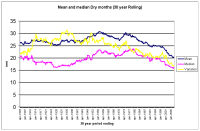Turning climate data into agricultural business decisions
Where?Victoria (Wimmera Region)
Who for? Not-for-profit agricultural group
What we did:
Where?
Large scale climate models are all fine and good, but what does climate change mean for my farm and my community? For farmers, one of the specific questions regards long term patterns in rainfall, so that is where we focussed. We also find that community groups, like business can have data stored in all sorts of places.
In this case, we were fortunate enough to have access to a 150 years of daily rainfall records, taken at a broadacre farm in the region. After our data entry staff forgave us, we set to work looking at where the nuggets of information were in this time-series data.© Symbolix
We were able to tease out seasonal and long term patterns in the data and to link this back to global climate changes, using NOAA datasets. For this region we found that the major climate effect is a steady decline in summer (non-growing season) rainfall. This has the effect of lowering the overall resilience of the land, as there is less underground “backup” when the dry growing seasons strike. We were also able to show very real, local examples of the impact of climate events like el Nino/la Nina, and the Pacific Decadal Oscillation.
This information was presented as a presentation and discussion with local farmers about how this information can be incorporated into farm risk planning.


